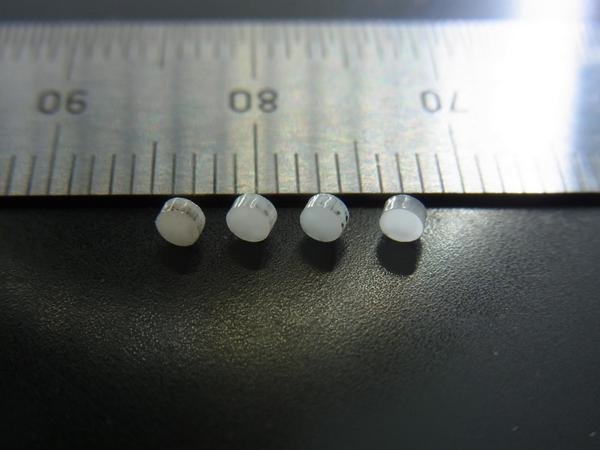
[Image above] Small samples of stishovite, a rare form of silica that exhibits strength and toughness. Credit: Nori Nishiyama; DESY
If someone calls you dense, tough, or amorphous, you’re not necessarily getting a compliment.
But if you’re a ceramic, those can be some shining attributes.
Silica comes in many different crystalline varieties, or polymorphs—some are pretty, some are not-so-stable, and some are really dense.
Stishovite is one of the densest. It’s also rather rare, as its formation requires high pressures and temperatures—like when a meteorite strikes quartz on the earth’s surface or at conditions found deep within the earth. Stishovite is only metastable though, meaning that if enough energy is added, it can switch to another form.
And natural stishovite is hard, but it’s also brittle. But synthesize it with a nanocrystalline structure, and it can become surprisingly tough—almost as tough as the gold standard of tough ceramics, zirconia.
To better understand how stishovite’s nanocrystalline structure makes the material tough—knowledge that could ultimately help design ceramics that are both super-hard and super-tough—scientists from the Deutsches Elektronen-Synchrotron and their international colleagues took a close look inside stishovite. What they saw was recently published in Scientific Reports.
Using electron microscopes and synchrotron X-rays, the team looked closely at fracture sites in nanocrystalline bulk stishovite and saw that the surfaces contained thin worm-like strands of amorphous silica.

Electron micrograph of wormlike structures of amorphous silica form at fracture surfaces. Credit: Nori Nishiyama; DESY
More amorphous silica present corresponded with tougher fractures, leading the researchers to believe that the transition to amorphous silica itself accounted for the toughening, according to a DESY press release.
“Actually, the transformation from stishovite to amorphous silica resembles the melting of ice,” lead researcher Nori Nishiyama says in the release. “Both are crystal-to-amorphous transformations that occur outside the stability field.”
That still doesn’t say why the transition makes stishovite more tough, but Nishiyama has an answer for that, too.
“This transition instantaneously doubles the volume of the material, effectively pushing against the fracture and stopping it short,” he says in the release. A similar process happens in zirconia to keep it tough, although that transition only causes an expansion of 4%.
“The transition now observed in stishovite expands the volume by 100%,” Nishiyama says. “It may be possible to create ceramics composites for industrial use that can exploit the toughening mechanism of stishovite.”
Amorphization of silicon under pressure is nothing new, but that the process can strengthen the bulk material is, and could lead to improved materials.
The paper is “Fracture-induced amorphization of polycrystalline SiO2 stishovite: a potential platform for toughening in ceramics” (DOI: 10.1038/srep06558).
